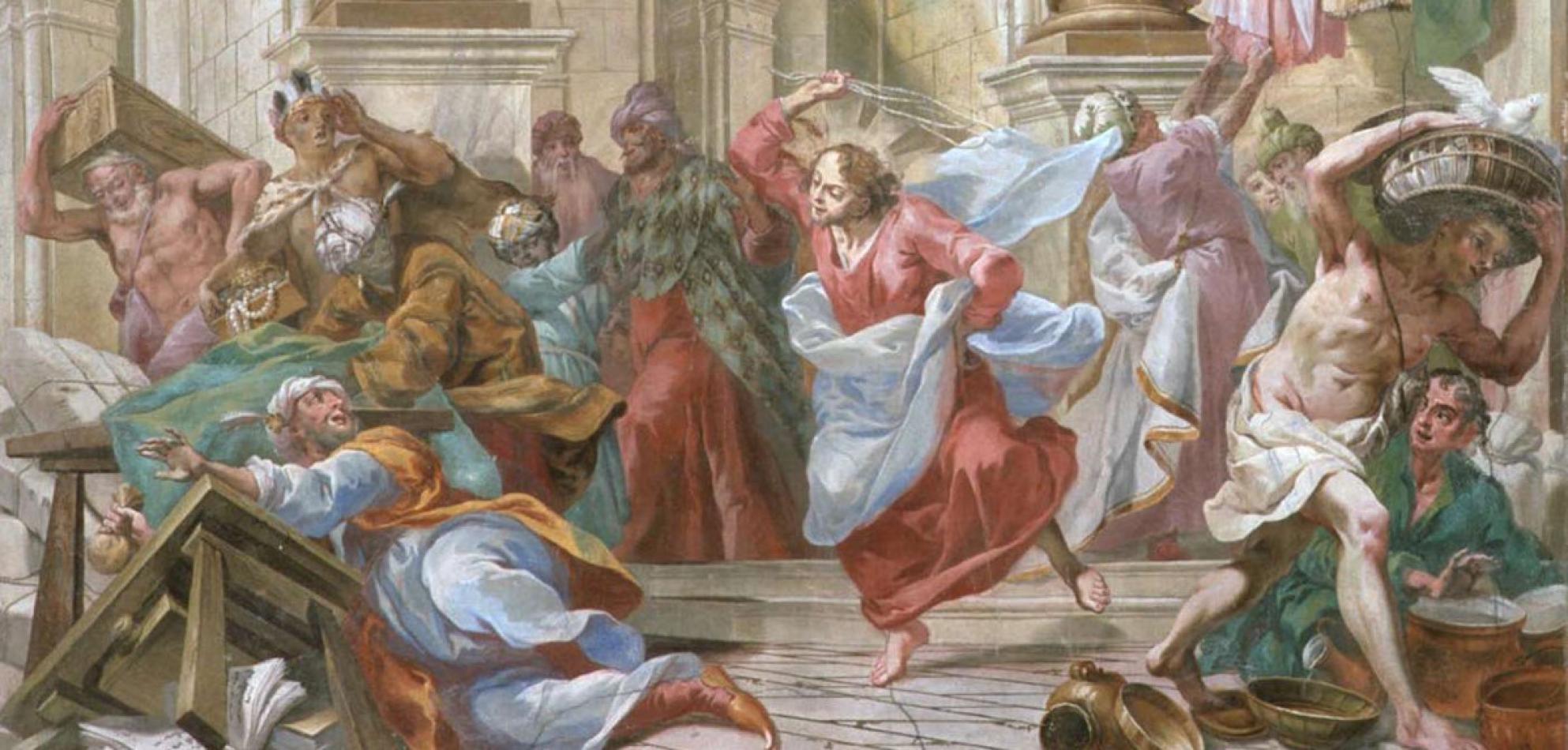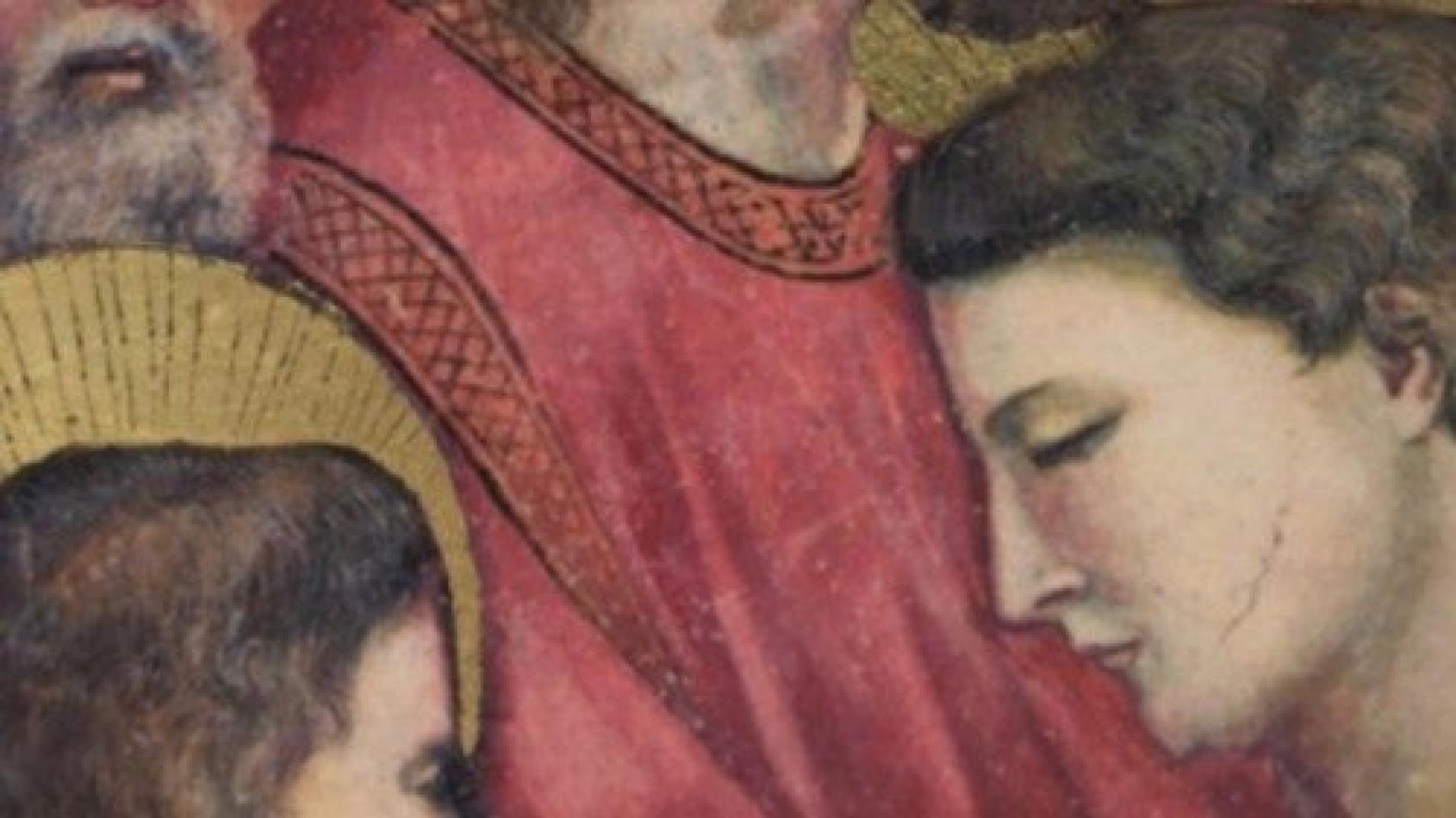Daniel Comboni
Comboni Missionaries
Institutional area
Other links
Newsletter
The scene of the expulsion of the merchants from the temple, is recorded by all four evangelists. This shows the importance they attributed to the fact. During Passover, Jerusalem was full of pilgrims, from all over the world to celebrate the festival, offer sacrifices and fulfill vows. The city, which normally counted fifty thousand inhabitants, on the occasion of Easter could reach hundred and eighty thousand.
Gospel Reflection
John 2:13-25
The scene of the expulsion of the merchants from the temple, is recorded by all four evangelists. This shows the importance they attributed to the fact. During Passover, Jerusalem was full of pilgrims, from all over the world to celebrate the festival, offer sacrifices and fulfill vows. The city, which normally counted fifty thousand inhabitants, on the occasion of Easter could reach hundred and eighty thousand. Therefore all the families were involved in hosting a few guests. Many pilgrims came from distant countries, after saving, made sacrifices and renouncements for years to afford, perhaps once in a lifetime, “a pilgrimage” (Ps 84:6). During the festive days they went to the temple to pray, to seek counsel from the priests, to offer burnt offerings to the Lord, to deliver their generous offers with copper coins, the only ones that could be used in the holy place. The money of Rome was declared legally unclean and had to be changed at the appropriate tables of money changers.
For the traders the time of the Passover was an opportunity not to be missed. In a few weeks they could accumulate more gains than throughout the rest of the year. Despite high prices, pilgrims thronged the shops from early morning until late at night. It was difficult for the temple priests to resist the temptation to get into a so profitable turnover. In fact, during the three weeks before Easter, under the arcades of the sacred precinct, they also opened their market. They decorated the royal porch for the sale of lambs. (It is said that, for the Passover meal, 18,000 oxen and other animals were sacrificed). At the bottom of the stairs that, from the southwest, led into the temple, four rooms intended for the moneychangers were extracted. They were operating a deduction of twelve percent for their commission. In and around the holy place, the comings and goings was indescribable. It was all a clamor of merchants, farmers, tanners, guards and pilgrims.
The aristocrats of Jerusalem, belonging to the sect of the Sadducees, were the beneficiaries of this trade. The managers were members of the family of the high priests Annas and Caiaphas who, for decades, maintained the control of economic and religious power of the capital.
The house of prayer had been transformed by its own ministers in a market place.
The dramatic episode narrated in today’s Gospel is inserted in this context. It is on the occasion of a Passover feast that Jesus came to the temple. He came across the unworthy spectacle described above (vv. 13-14).
The emotions that he experienced are not referred to by any evangelist, but they are easy to understand, considering the reaction he had. He did not say a word; he made a whip, probably using ropes with which the beasts were tied. Then he began to furiously cast out all from the royal porch. He upended chairs, money, cages of doves. Then, without pausing, he went down the staircase, and took the moneychangers by surprise. He overturned their tables and threw down the coins that they piled on top.
John, the only one among the evangelists, notes that, in addition to the vendors, sheep and oxen were also driven out (v. 15).
The gesture of Jesus has decreed the end of religion related to the offering of animals. He declared God’s refusal of bloody sacrifices whose inconsistency had been denounced by the prophets: “What do I care — says the Lord — for your endless sacrifices? I am fed up with your burnt offerings, and the fat of your bulls. The blood of fatlings and lambs and he-goats I abhor” (Is 1:11). In the greatest proof of love that Jesus was going to give, the only sacrifice pleasing to the Father would be shown, the one, John would have said to the Christians of his community: “This is how we have known what love is; he gave his life for us, for our brothers and sisters” (1 Jn 3:16).
The gesture made by Jesus in the temple is amazing. From one who presented himself “meek and humble of heart” (Mt 11:29), no one would have expected a similar reaction, almost unsettling. Why has he behaved in this way? The explanation lies in the two sentences he uttered.
The first: “Take all this away, and stop turning my Father’s house into a marketplace” (v. 16). He was referring to an oracle of the prophet Zechariah who, after announcing the appearance of a completely renovated world in which the Lord would become king over all the earth, and the country would be transformed into a garden, concluded: “There will no longer be merchants in the house of the Lord” (Zech 14:21).
By purifying the temple of the merchants, Jesus pronounced his severe, final sentence against mingling religion and money, between worship the Lord and economic interests. God expects only love from man and love is free. It shows and nourishes itself only through generous and disinterested gifts. To avoid dangerous misunderstandings, Jesus ordered his disciples: “You received this as a gift, so give it as a gift. Do not carry any gold silver or copper in your purses. Do not take a traveler’s bag, or an extra shirt, or sandals, or a staff: workers deserve their living” (Mt 10:9-10).
The most important teaching is, however, in the second sentence: “Destroy this temple and in three days I will raise it up” (v. 19). He was not referring to more trade and unworthy traffic that took place in the sanctuary, but the inauguration of a new temple. He announced the beginning of a new cult. The comment of the evangelist is a clarifier: “He was referring to the temple of his body” (v. 21).
The Jews believed that God dwelt in the sanctuary of Jerusalem, where they flocked to offer sacrifices. Jesus said that this religion had now fulfilled its function.
The dramatic scene of the rending of the temple’s veil (Mt 27:51) would mark the end of all the holy spaces, of all places reserved to the encounter with God. It was the solemn declaration that the time of the separation between the sacred and the profane is over. Wherever one is, who is in communion with Christ is united with God and can worship the Father.
Jesus’ gesture is not equivalent to a simple correction of abuses, but the announcement of the passing of the temple, regarded as a guarantee of the presence of God and salvation. One’s encounter with God would no longer be in a particular place, but in a new temple: the body of the risen Christ.
To the Samaritan woman who asked him the place where the Lord is worshipped, Jesus replied: “Believe me, woman, the hour is coming when you shall worship the Father, but that will not be on this mountain nor in Jerusalem. The true worshippers will worship the Father in spirit and truth; for that is the kind of worshippers the Father wants” (Jn 4:21-24).
Some New Testament texts make clear in what consists the new worship introduced by Jesus. In writing to the Romans, Paul recommends: “I beg you, dearly beloved, by the mercy of God, to give yourselves as a living and holy sacrifice pleasing to God; that is the kind of worship for you, as sensible people.” (Rom 12:1) and the author of the Letter to the Hebrews: “Do not neglect good works and common life, for these are the sacrifices pleasing to God” (Heb 13:16). James concretized even more the content of the new cult: “Pure and blameless religion lies in helping the orphans and widows in their need and keeping oneself from the world’s corruption” (Jas 1:27). These sacrifices that the Christian is called to offer do not take place in a sacred ambient nor through rites, but in life itself.
The construction of the new church began—as is repeated twice in today’s Gospel—after three days (v. 20), that is, on Easter day.
Raising from the dead his own son, the Father has laid the cornerstone of the new sanctuary. Peter urges the newly baptized in his community to be united to Christ, “living stone, rejected by people but chosen by God and precious to him.” He explains: “Set yourselves close to him so that you, too, become living stones built into a spiritual temples, spiritual sacrifices that please God” (1 Pet 2:4-5).
Now it is clear: the only sacrifice acceptable to God is the gift of life; they are the works of love, the selfless service rendered to persons, especially the poorest, the sick, the marginalized, the hungry and the naked. Who stoops in front of a brother to serve him, performs a priestly gesture: united to Christ, the temple of God, who brings to heaven the sweet aroma of a pure and holy offering.
What is the point then of our solemn liturgies, sacraments, chanting, processions, pilgrimages, community prayers, devotional practices?
They don’t give anything to God; they do not add anything to his perfect joy.
The religious manifestations respond to a deep human need: to celebrate, through gestures and sensible signs, individually and in community, what one believes in. The sacraments are signs by which God communicates his Spirit and man expresses his gratitude to him for this gift. The error is to assume that the performance of rituals is sufficient to establish a good relationship with the Lord and that participation in the solemn celebrations can replace the concrete works of love.
The Gospel ends with a surprising information: during the feast, Jesus performed signs and many people believed in him, but he did not trust himself to them because he knew them all and knew what was in every man (vv. 23-25).
The reason for this detached attitude of Jesus is that these people were drawn to him not because they were attracted by his message, but because they had witnessed miracles. The faith that needs to see, to verify outstanding works is fragile. Jesus would not trust, not even today, one who seeks him as a miracle worker. True faith is to accept to become, with him, the living stones of the new temple and in sacrificing one’s life for the brothers and sisters.
Fr. Fernando Armellini
https://sundaycommentaries.wordpress.com/
Cleansing of the Temple
JEWS DEMAND SIGNS AND GREEKS LOOK FOR WISDOM
Lectio
You may find strange the title I have given to this Lectio, but I think the text from 1 Corinthians that we read today can offer us the right approach to our Sunday liturgy and to the mystery of Jesus’ death and resurrection that we will celebrate at Easter. Let us go step by step. The first reading, if we put aside the strictly religious section concerning obedience to Yahweh as the only true God, is completely “reasonable.” We can find similar commandments and regulations in Hammurabi’s Code and in some other ethical or legal systems. It is logical and reasonable to conceive a society and a style of life in which basic rights and duties referring to propriety, life, marriage and family are respected and whose transgressions are punished. The problem for Greeks (Gentiles, or non-believers in general) is the way Jesus understands and interprets the Law of Israel, and even what we call natural law: considering yourself an adulterer, just because you desired someone else’s spouse; feeling happy when persecuted or living in poverty? For Greeks, that was simply absurd. Giving your life for a just person? Depending on the circumstances and the attachment you felt, that could be acceptable. “Indeed, only with difficulty does one die for a just person, though perhaps for a good person one might even find courage to die” (Romans 5:7; read the whole passage). Frankly, taken as a whole, the way of understanding life, the path proposed by Jesus and his Gospel, seemed foolishness to Greeks in Paul’s time, and even today it demands a rational jump into the void that only through faith do we dare go. No, from a Greek viewpoint, there is no “wisdom” in our Christian message.
In our fragment from John’s Gospel, the context is different from that of the Synoptics. Although it is set at the time of Passover, it does not take place in Jesus’ “last week,” just before his death, but at the very beginning of his ministry. Jesus does not blame the merchants for being “thieves or bandits,” but for having turned the Holy Shrine into a simple marketplace. In fact, they are an image of the way in which the priests have defiled the true worship of God by transforming the Temple into a type of mall where rites and sacrifices have replaced the attachment of the heart to the spirit of the Law. Unfortunately, even the observant Jews had forgotten its authentic meaning: “I desire mercy, not sacrifice” (Matthew 9:13, Hosea 6:6). But the authorities, who had seen Jesus overturning the tables of the money changers and driving them out of the Temple, together with the merchants, had good reasons to ask for a “sign” that explained Jesus’ violent reaction. And, even if he had pronounced them, those words from the Scripture could not be the “sign” they expected as an answer. In fact, Jesus’ criticism went deeper than that ethical approach. When reading his dialogue with the Samaritan woman, one has the feeling that he questions the concept of worship as such. After his own sacrifice no sacred place will be needed, for “the hour… is now here, when true worshippers will worship the Father in spirit and truth… God is spirit, and those who worship him must worship in sprit and truth” (John 4:19-26). That Temple/marketplace that Jesus rejects will be replaced by his own death in fulfillment of his Father’s plans. He will be the new Temple, the final priest and the only sacrifice that will reconcile us with the Father. But the Jews cannot understand and accept that as the real sign of the New Covenant – his death on the cross and his resurrection, his body as the true Temple which no human power will ever destroy. The disciples themselves were not able to understand his words until he was raised from the dead. According to Paul, Jesus’ death on the cross would always remain a stumbling block. No, the Jews could not be satisfied with that kind of sign.
Meditatio
The truth is today’s texts, especially those from 1 Corinthians and John’s Gospel, must have disconcerted and turned upside down the ideas of the Jews of that time concerning salvation and the role that both the Law and worship should play. The New Covenant was really “new” and did not fit into their logical and religious schemes. But, if we are sincere, we Christians have not felt too comfortable or satisfied with it, for we have transformed it into something as musty as the Old one. Even if I run the risk of sounding unorthodox, I sometimes have the feeling that our liturgy, the way we celebrate sacraments, pray and worship God, seems closer to Levitical religiosity than to the newness of the celebrations of the New Testament. History is history, and we have to respect it and accept our heritage, but haven’t we fallen into the old trap of conceiving worship as some kind of “trade” between us and God? Do we offer our rites and gestures in exchange for blessings? Has the Word of God, the most vital and renewed part of our liturgy, become another worn-out rote? Do we “live” the Eucharist as a sharing in the one and final sacrifice of Jesus on the cross, or do we simply “attend” a rite as if we were in Jerusalem’s Temple?
Oratio
Let us pray for ourselves who so often hide our lack of commitment to Jesus and his Gospel behind a cloud of rites and celebrations: that we may live liturgy and worship as a source of renewal for our Christian life.
Pray for those (including ourselves, of course) who live the Eucharist or other acts of worship with a weary attitude: that they (we) may discover that in our rites it is Christ himself, our High Priest, who baptizes, celebrates the Eucharist and forgives sins.
Contemplatio
“Contemplate,” pay attention to the way you celebrate and pray in your community and try to find the traps of repetition into which we have fallen. Is there a team preparing your weekly or daily worship? Do you cooperate with them? Could you do something to help them renew their activity? I am sure you can find something that can be improved. In any case, even if nothing can or must be done, you will have become aware of that dimension of your community.
Reflections written by Rev. Fr. Mariano Perrón,
http://www.americanbible.org/resources/lectio-divina
Cleansing of the Temple
John 2:13-25
Context and structure of the text
Our passage follows immediately on the first sign that Jesus gave in Cana of Galilee (2:1-12). Some expressions and phrases are repeated in both scenes and lead us to think that the author wanted to contrast the two scenes. In Cana, a village in Galilee, during a wedding feast, a Jewish woman, the mother of Jesus, expresses her unconditional faith in Jesus and invites others to accept his word (2:3-5). On the other hand, “the Jews”, during the Paschal celebration in Jerusalem, refuse to believe in Jesus and do not accept his word. In Cana, Jesus worked his first sign (2:11) and here the Jews ask for a sign (v.18) but then do not accept the sign Jesus gives them (2:20).
The development of our little story is quite simple. Verse 13 places in a framework a context of space and time that is very precise and significant: Jesus goes to Jerusalem for the Paschal feast. Verse 14 introduces the scene that provokes a strong reaction on the part of Jesus. Jesus’ action is described in verse 15 and is caused by Jesus himself in verse 16. Jesus’ action and words in turn provoke two reactions. First, that of the disciples, one of admiration (v.17); secondly, that of the “Jews”, one of dissent and indignation (v.18). They want an explanation from Jesus (v.19) but they are not open to receive this(v.20). At this point the narrator intervenes to interpret Jesus’ words authentically (v.21). “The Jews” cannot understand the real meaning of Jesus’ word. However, also the disciples, who admire him as a prophet full of zeal for God, cannot grasp the meaning now. It is only after the fulfilment that they will believe in Jesus’ word (v22). Finally, the narrator offers us a brief account of Jesus’ reception by the crowds in Jerusalem (vv.23-25). Yet, this faith, founded only on his signs, does not enthuse Jesus.
A key to the reading: Jesus, new temple
The temple in Jerusalem was the place of the presence of God in the midst of the people. Yet the prophets constantly insisted that it was not sufficient to go to the temple and offer sacrifices there in order to be accepted by God (see Is 1:10-17; Jer 7:1-28; Am 4:4-5; 5:21-27). God wants obedience and a life morally straight and just. If the exterior cult does not express such a vital attitude, then it is empty (see 1 Sam 15:22). Jesus inserts himself in that prophetic tradition of the purification of the cult (see Za 14:23 and Mi 3:1 for the action of the coming “Messiah” in this context). The disciples admire him for this and immediately think that for this attitude he will have to pay personally like Jeremiah (see Jer 26:1-15) and other prophets. But in John’s Gospel, Jesus’ action is more than just a prophetic gesture of zeal for God. It is a sign that prefigures and proclaims the great sign of the death and resurrection of Jesus. More than just a purification, that which Jesus does is to abolish the temple and the cult there celebrated, because from now on the place of the presence of God is the glorified body of Jesus (see Jn 1:51; 4:23).
http://ocarm.org/




